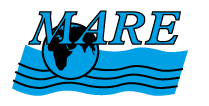Ocean Sciences Curriculum Sequence for Grades 3–5 Overview
The Ocean Sciences Curriculum Sequence for Grades 3–5 contains three thematic units based on the Ocean Literacy: Essential Principles and Fundamental Concepts as well as the Ocean Literacy Scope & Sequence for Grades K–12. Each unit may be taught independently or as a progression of all three units and is appropriate for all three grades. The Grades 3–5 Sequence engages students in exploring ocean currents, features of the ocean floor, ocean habitats, ocean organism diversity, ocean food webs, adaptations to the ocean environment, and human interconnections with the ocean including exploration, technology, pollution and solutions. This upper elementary curriculum prepares students to understand the climate ocean connection and climate change curriculum they will be exposed to in middle school.
- Unit 1: What kind of place is the ocean? covers Earth and physical science themes about the ocean as a physical space with unique characteristics (e.g., features of the ocean floor; properties of ocean water such as salinity, temperature, and pressure; and ocean currents).
- Unit 2: What is life like in the ocean? covers life science themes, with a specific focus on food webs, habitats, and adaptations.
- Unit 3: How are humans and the ocean interconnected? covers life science and environmental science themes, with a specific focus on how humans use the ocean, pollution, fisheries, and how people can help care for life in the ocean.
If you are interested in the purchase or implementation of this curriculum, please contact us directly at gems@berkeley.edu




